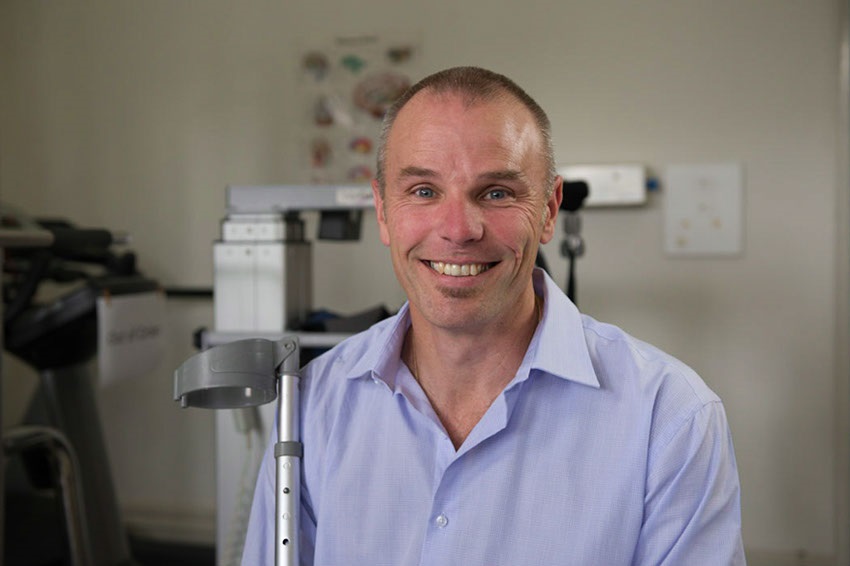Safe resumption of high-level mobility and cardiovascular fitness following traumatic brain injury
-

Prof Gavin Williams -

Ms Sara Aldous
Project Details
Traumatic Brain Injury is the leading cause of disability in people aged 15-45 and is predicted to be the third leading cause of global burden of disease by 20202. Survivors of TBI have persistent low levels of physical activity (PA) increasing their risk of developing comorbidities such as cardiovascular disease, type two diabetes and psychosocial problems. The average life expectancy in TBI is reduced by seven years, with higher rates of mortality related to circulatory disease. Therefore early resumption of regular PA is important for the long-term health of people with TBI.
Historically, early management of TBI was to undertake physical rest (lying flat in bed) for three weeks in duration. Concussion and mild TBI (mTBI) recommendations have moved to a more active rehabilitation approach of graded return to physical activity commencing as early as possible following injury. This is because prolonged rest can negatively affect the cardiovascular, musculoskeletal, respiratory, psychological and immune systems, and has been associated with worse outcomes following concussion. Although extensive guidelines for management of moderate-to-severe TBI recommend exercise therapies in rehabilitation, none provide recommendations around when exercise should commence or how patients should be monitored. In marked contrast, the Concussion in Sport Group produce a four-yearly consensus statement to provide doctors, clinicians and sports trainers with explicit guidance and recommendations for resumption of activity after sport-related concussion. However, it is unclear whether these recommendations should apply to those with more severe classifications of TBI.
Given concussion is at the mild end of the TBI spectrum, it seems reasonable to suggest that the symptoms associated with, or provoked by, early exercise following concussion may be similar in more severe classifications of TBI. However, as this has yet to be established, it is important to investigate when it is safe (length of time post injury), and what happens (at a symptom level) when people exercise after moderate-to-severe TBI. Although there is a range of potential factors that may provoke post-concussion-like symptoms; such as exercise, stress or cognitive demand, the focus of this project is high-level mobility and cardiovascular exercise.
Primary aim
Develop implementation recommendations for exercise following moderate to extremely severe TBI
Secondary aims
- establish the incidence and severity of exercise-induced symptoms
- establish the timeframe for resolution of these symptoms
- establish the psychometric properties of the Sway Concussion Management System and Immediate Post-concussion Assessment and Cognitive Testing Quick Test (ImPACT) in a moderate to severe TBI population.
Researchers
- Sara Gallow (nee Aldous)
- Prof Jennifer McGinley
- Prof John Olver
- Prof Gavin Williams
Collaborators
Funding
- 2019 Epworth Medical Foundation Capacity Building Grant. When is it safe to commence physical activity following traumatic brain injury? ($24,881)
- 2018 Epworth Medical Foundation Translational Research Grant. When is it safe to commence physical activity following traumatic brain injury? ($25,000)
- 2017 PRoSpER/Epworth Medical Foundation joint scholarship. When is it safe to resume cardiovascular and high-level mobility training after traumatic brain injury? ($50,000)
Research Outcomes
- Gallow S, Hilet L, Sutherland E, McGinley J, Olver J and Williams G. Current practice in high-level mobility prescription in the early sub-acute phase following traumatic brain injury: A systematic review. (Under review at Disability and Rehabilitation)
- Gallow S, McGinley J, Olver J and Williams G. Exercise-induced symptom provocation in traumatic brain injury: Preliminary results. Free paper presentation at the National Australian Physiotherapy Association Conference, Adelaide, November 2019.
- Spencer T, Aldous S, Williams G and Fahey M. Systematic review of high-level mopbility training in people with a neurological impairment. Brain Injury 2018;32(4):402-415
- Aldous S and Williams G. Return to exercise following traumatic brain injury: Are we forgetting those who need it most? (Editorial) International Journal of Therapy and Rehabilitation 2017;24(6):189-190
- Aldous S, DiNicolantonio L, McGinley J, Olver J and Williams G. When is it safe to commence high-level mobility after a traumatic brain injury: A systematic review. Free paper presentation at the National Australian Physiotherapy Association Conference, Sydney, October 2017 – Winner of ‘best paper by a clinician’ in the National Neurology Group category.
Research Group
Faculty Research Themes
School Research Themes
Neuroscience & Mental Health, Practice and service improvement, Recovery and Rehabilitation Across the Lifespan
Key Contact
For further information about this research, please contact the research group leader.
Department / Centre
MDHS Research library
Explore by researcher, school, project or topic.